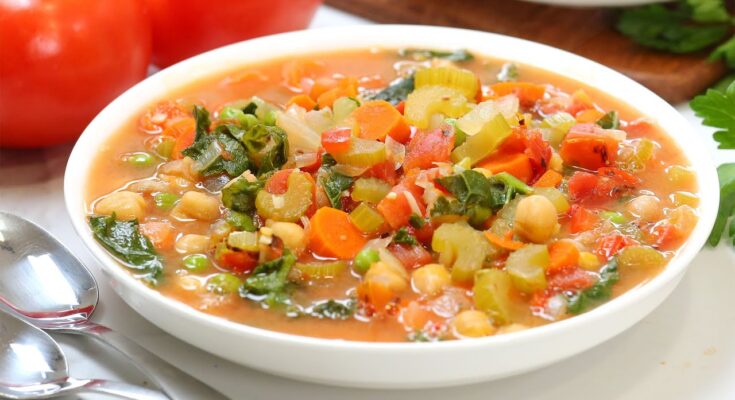Vegetable Soup Recipe: Vegetable soup is one of those comforting, nourishing meals that never goes out of style. Whether you’re trying to eat healthier, save some money, or warm up on a chilly day, this homemade vegetable soup recipe has you covered. The beauty of this dish lies in its versatility. You can customize it with whatever veggies you have on hand and season it to your taste.
In this guide, we’ll walk you through every step to create a delicious pot of soup that’s both easy to make and loaded with nutrients. Even if you’re a beginner in the kitchen, by the end of this, you’ll have a homemade soup that tastes like it’s been simmering for hours.
Ingredients You’ll Need
Here’s a list of basic ingredients for this vegetable soup recipe:
- Olive oil or butter (for sautéing)
- Onions – 1 medium, chopped
- Garlic cloves – 2-3, minced
- Carrots – 2 large, diced
- Celery – 2 stalks, chopped
- Potatoes – 2 medium, cubed
- Zucchini – 1 small, sliced
- Tomatoes – 2 large, chopped (or 1 can diced tomatoes)
- Vegetable broth – 4-5 cups
- Salt and black pepper – to taste
- Herbs (bay leaves, thyme, parsley)
- Optional: Spinach, peas, green beans
Feel free to add other veggies like bell peppers or squash for more variety.
Kitchen Tools Required
- Large pot or Dutch oven
- Cutting board and knife
- Wooden spoon for stirring
- Measuring cups and spoons
- Immersion blender (optional)
Preparing the Vegetables
Start by washing all your vegetables thoroughly to remove any dirt. Dice harder vegetables (like potatoes and carrots) into even pieces to ensure they cook evenly. For leafy greens like spinach, give them a rough chop. If you’re using fresh herbs, chop those as well.
How to Make Vegetable Soup Recipe – Step by Step Guide
Step 1: Heating the Oil or Butter
Heat 2-3 tablespoons of olive oil or butter in a large pot over medium heat. This will form the base of your soup and help soften the vegetables without burning them. If you want to infuse more flavor, try adding a pinch of chili flakes or herbs like thyme at this stage.
Step 2: Sautéing the Aromatics
Add chopped onions, garlic, and celery to the hot oil. Stir frequently for 3-5 minutes until the onions turn translucent and the garlic becomes fragrant. This step builds the base flavor for your soup.
Step 3: Adding Vegetables
Now, add the harder vegetables like carrots, potatoes, and celery first since they take longer to cook. Give them a quick stir to coat with oil, then add the softer ones like zucchini and spinach. Don’t add everything at once—layering the ingredients allows flavors to build gradually.
Step 4: Adding Liquid
Pour in the vegetable broth or water. The amount you use depends on how thick you want the soup. For a chunkier soup, stick with 4 cups; for something brothier, go for 5-6 cups. Bring everything to a boil.
Step 5: Seasoning the Soup
Add salt, black pepper, bay leaves, and any other herbs you like. Thyme and parsley work particularly well. If your soup tastes too acidic, try adding a small pinch of sugar to balance it out.
Step 6: Simmering the Soup
Reduce the heat to low and let the soup simmer for about 20-30 minutes. Stir occasionally to ensure nothing sticks to the bottom of the pot. Simmering helps all the flavors come together beautifully.
Step 7: Blending (Optional)
If you prefer a smooth soup, now’s the time to blend it. You can use an immersion blender directly in the pot or transfer the soup in batches to a standard blender. Leave some chunks if you want a mix of textures.
Step 8: Taste and Adjust Seasoning
Once the soup is done simmering, give it a taste. Add more salt or pepper if needed. A squeeze of lemon juice at the end can brighten the flavors, and fresh herbs like parsley make for a nice finishing touch.
Tips for Perfect Vegetable Soup Every Time
- Balance flavors: A touch of acidity (like lemon) brings the soup to life.
- Texture matters: Leave some vegetables chunky for a rustic feel, or blend part of the soup for a creamier consistency.
- Don’t overcook: Add delicate veggies (like peas) toward the end to keep them bright and fresh.
Substitutions and Variations
- Vegan option: Use plant-based broth and skip any dairy toppings.
- Gluten-free: Ensure your broth is gluten-free, or use homemade stock.
- Protein boost: Add cooked beans, tofu, or shredded chicken.
How to Serve Vegetable Soup
Pair your soup with warm crusty bread, garlic breadsticks, or crackers. If serving guests, garnish with fresh parsley and a sprinkle of Parmesan cheese for a fancy touch.
Storage and Freezing Tips
- Refrigerate leftovers: Store in an airtight container in the fridge for up to 4 days.
- Freeze for later: Freeze individual portions in zip-lock bags for up to 3 months.
Common Mistakes to Avoid
- Over-seasoning: Start with small amounts of salt and adjust gradually.
- Wrong veggie ratio: Too many starchy vegetables can make the soup heavy.
- Boiling the soup too long: Simmer instead of boil to avoid mushy vegetables.
Health Benefits of Vegetable Soup
Packed with fiber, vitamins, and minerals, vegetable soup offers numerous health benefits. It’s low in calories, aids digestion, and helps with weight management. Plus, it’s a great way to sneak in more vegetables into your diet!
How to Make it Kid-Friendly
- Cut veggies into fun shapes: Use cookie cutters to make stars or hearts.
- Mild seasoning: Keep the flavors simple and avoid spicy herbs.
- Involve kids in preparation: Let them help with washing or stirring to get them excited about eating the soup.
FAQs about Vegetable Soup Recipe
What vegetables can I use in vegetable soup?
You can use a variety of vegetables in your soup, including but not limited to carrots, potatoes, celery, tomatoes, onions, green beans, and peas. Feel free to use fresh, frozen, or even leftover vegetables.
Do I need to use stock for vegetable soup?
While using vegetable, chicken, or beef stock can enhance the flavor of your soup, it’s not mandatory. You can also use water with herbs and spices to create a tasty broth.
How can I make my vegetable soup more flavorful?
Incorporate herbs like parsley, thyme, and bay leaves. Garlic, onions, and celery also add depth. For a richer flavor, sauté the vegetables before adding the liquid.
Is vegetable soup healthy?
Yes, vegetable soup is packed with nutrients, low in calories, and can be very filling. It’s a great way to include a variety of vegetables in your diet.
Can I freeze vegetable soup?
Absolutely! Vegetable soup freezes well. Let it cool completely before freezing in suitable containers. It’s perfect for meal prep and can be stored for up to 3 months.
How can I thicken my vegetable soup?
To thicken your soup, you can blend part of the soup to create a thicker texture or add ingredients like potatoes, beans, or a small amount of cornstarch or flour dissolved in water.
What are some quick tips for serving vegetable soup?
Serve your vegetable soup with a sprinkle of fresh herbs, a dollop of pesto, or a spoonful of yogurt. For a heartier meal, pair it with crusty bread or a grilled cheese sandwich.
Conclusion
Making vegetable soup at home is easier than you think, and the rewards are well worth the effort. With just a few basic ingredients and some patience, you can whip up a comforting, nutritious meal that suits your taste buds perfectly. Don’t be afraid to experiment with different veggies and seasonings – this is your chance to get creative in the kitchen!
References
To further enhance your vegetable soup-making experience, we recommend consulting these reputable sources. These links provide additional insights and variations on the recipe, ensuring you have all the information needed to refine your culinary skills.
- Epicurious – Vegetable Soup Recipes: Explore a collection of vegetable soup recipes curated by culinary experts. Perfect for chefs of all skill levels looking to diversify their soup-making. Read more at Epicurious.
- Allrecipes – How to Make the Best Vegetable Soup: This comprehensive guide offers step-by-step instructions, user reviews, and nutritional information, making it an ideal resource for home cooks. Visit Allrecipes here.
- Food Network – Healthy Vegetable Soup Recipes: Discover healthy and flavorful vegetable soup recipes from renowned chefs, featuring tips to enhance taste and nutrition. Learn more on Food Network.
These sources are well-respected in the culinary world and provide a wealth of knowledge that can help both novice and experienced cooks alike create delicious and nourishing dishes.



